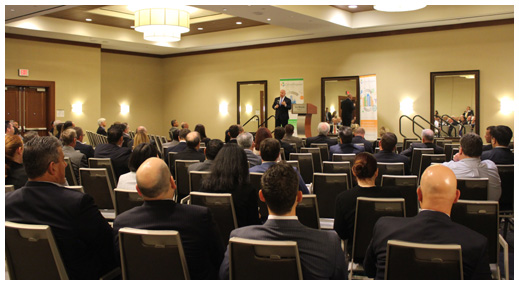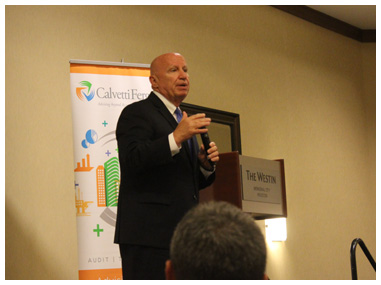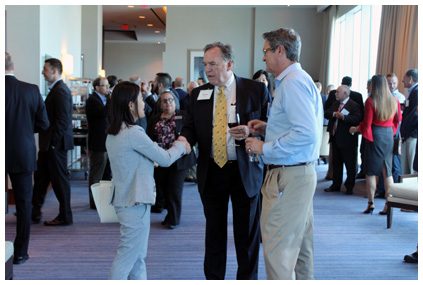 Last month U.S. Representative Kevin Brady addressed Houston-area business professionals at the Calvetti Ferguson Energy Forum and Cocktail Reception. The event was sponsored by Calvetti Ferguson, a financial accounting and advising firm specializing in the fields of energy, construction, hospitality and multinational businesses. Attendees had ample opportunity to network before and after the presentation while enjoying hors d'oeuvres and drinks in the Wisteria Ballroom of the Westin Houston – Memorial City hotel.
Last month U.S. Representative Kevin Brady addressed Houston-area business professionals at the Calvetti Ferguson Energy Forum and Cocktail Reception. The event was sponsored by Calvetti Ferguson, a financial accounting and advising firm specializing in the fields of energy, construction, hospitality and multinational businesses. Attendees had ample opportunity to network before and after the presentation while enjoying hors d'oeuvres and drinks in the Wisteria Ballroom of the Westin Houston – Memorial City hotel.
Brady spoke about several topics, including his work in Congress on tax reform. He said that he was encouraged at the number of companies that are bringing back investments to the United States in the short-term, and the longer-term goal of influencing the locations of businesses. He that one business owner from Boston recently said to him “We like to do our manufacturing where we do our research, and so that is going to happen in New England if we can find workers to do the manufacturing.” Another business owner of a Houston-based company recently announced that due to the financial benefit they expect to receive under the new tax code, “they’re investing in new facilities, they’re investing in their workforce, and they’re investing in new technologies to remain productive and become competitive going forward.” Not only that, the company plans to build those new facilities in (and hire workers in) the United States rather than in other countries now that the tax code justifies keeping those investments here.
Another business owner of a Houston-based company recently announced that due to the financial benefit they expect to receive under the new tax code, “they’re investing in new facilities, they’re investing in their workforce, and they’re investing in new technologies to remain productive and become competitive going forward.” Not only that, the company plans to build those new facilities in (and hire workers in) the United States rather than in other countries now that the tax code justifies keeping those investments here.
Brady said that in the recent past, economists all declared that the slow growth rate of the economy was the “new norm” and there was nothing that would change that. Brady and his colleagues were not willing to accept that, which is why they decided to work to reform the tax codes. He said the work is not complete, and he asked the business leaders in the room to write to the House Ways and Means Committee with questions and suggestions, so that by fall they will have a better, more finely-tuned version of the proposed law. He said:
“The culture in Washington is to wait 30 years between major tax reforms: to let our code drift farther and farther behind our competitors, to try to address it by stuffing it full of special provisions that usually just make it more complicated and create another group that wants those special provisions – that’s been the culture.”
Brady wants to change that way of thinking. He said the main goals for the final version of the tax reform are:
- Permanence – past changes have been long-term but not permanent, but “for growth, and for certainty, permanence matters.”
- Retirement Savings – families are not saving enough and are not starting to save early enough. Brady said we need to change the way we incentivize savings in America.
- Innovation – “The country that wins the innovation race wins, just wins period, economically and otherwise. … What more can we do to encourage innovation?”
Brady then brought up the workforce shortage businesses are facing. He said that economists are unconvinced that the United States will develop its workforce and take full advantage of this new tax code. He said:
“I can’t find an industry, and few businesses that aren’t starved for workers or who don’t see real problems looking ahead at their workforce. And what a shame if that problem of a skilled workforce—and sometimes unskilled workforce – we can’t solve that in order to increase our economic growth.” Brady said that we need to fix the immigration policy because we need to be able to “recruit from around the world.” He said we also need more workforce training programs because those we have “are not producing the numbers we need.” Brady then stated that we need welfare reform to fill the jobs gap. He said:
Brady said that we need to fix the immigration policy because we need to be able to “recruit from around the world.” He said we also need more workforce training programs because those we have “are not producing the numbers we need.” Brady then stated that we need welfare reform to fill the jobs gap. He said:
“We have got millions of Americans who are stranded on the side lines trapped in the welfare system. Good people trapped in the welfare system. And so, before we left for Memorial Day weekend on Thursday, the Ways and Means Committee passed out the first welfare reform in 22 years because the timing is perfect. Demand for jobs, millions of people stranded on the side lines – what do we do to get them to the front lines of employment?”
The Committee has proposed that people who are work-eligible and on welfare be given work plans tailored to each individual signed by those individuals and by the states in which they live. These work plans will get those people transitioned back into the workforce. The plans may include training, childcare, or transportation, but each work-eligible person will be expected to work or to train for a job. The original welfare focused on families, especially single mothers, but the new proposal includes  getting all work-eligible people back to work whether they are men, women, single, or parents. The original welfare goal was to get people into any jobs, even if some jobs were temporary. Now success will be defined as getting people into jobs and keeping them there long-term, where they can “climb that economic ladder.”
getting all work-eligible people back to work whether they are men, women, single, or parents. The original welfare goal was to get people into any jobs, even if some jobs were temporary. Now success will be defined as getting people into jobs and keeping them there long-term, where they can “climb that economic ladder.”
The final part of the proposed welfare reform would be to make the system more transparent. The current system allows states to divert welfare money to other programs and has no accountability for how many people have been trained for or transitioned into the workforce. The Committee is proposing giving each state’s program a “grade” to reflect their success rate in putting people on a path to work.
Brady closed with this statement:
“It does tie to tax reform because this is all about maximizing growth and opportunities for this country and for people. We can’t leave folks who are on the sidelines behind, either. And our message to them isn’t ‘get off your dead butts.’ Our message is ‘we need you, you know, our economy needs you, and by the way, your children need to see you go to work each day.’ That’s priceless going forward. So, we’ve got a lot of work to do going forward.”
The event concluded with a question and answer session before the crowd dispersed to face the Houston afternoon rush-hour traffic.


